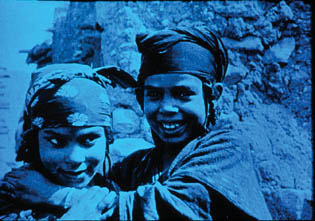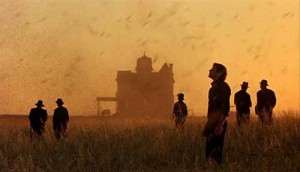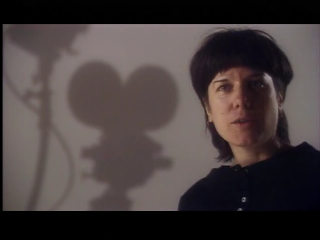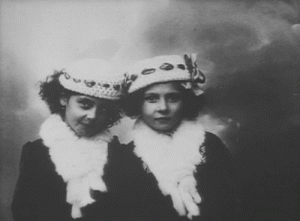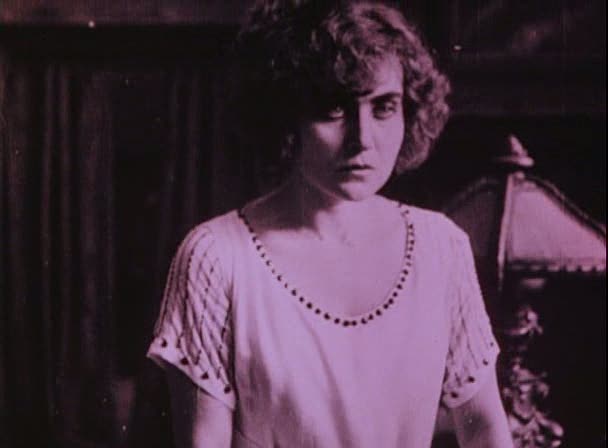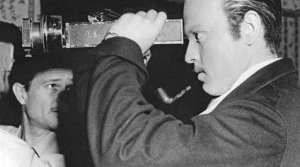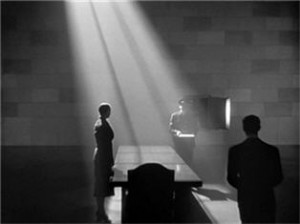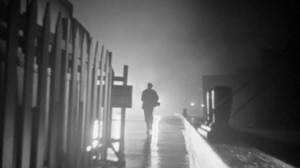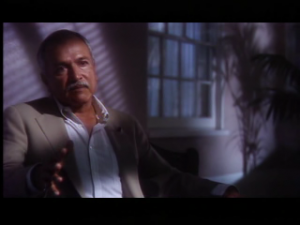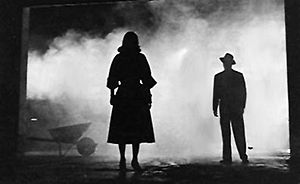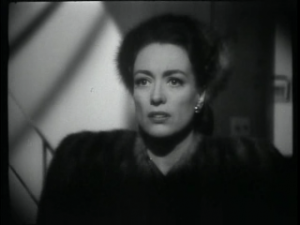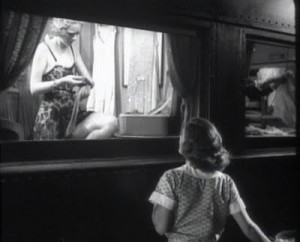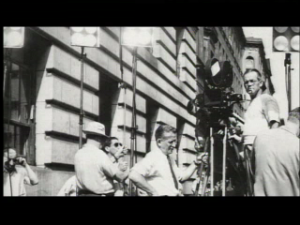From the Chicago Reader (August 6, 1993). — J.R.
LYRICAL NITRATE *** (A must-see)
Directed and written by Peter Delpeut
VISIONS OF LIGHT: THE ART OF CINEMATOGRAPHY *** (A must-see)
Directed by Arnold Glassman, Todd McCarthy, and Stuart Samuels Written by Todd McCarthy.
I realize it sounds strange to put it this way, but the special pleasures to be found in Lyrical Nitrate -– a 50-minute compilation of fragments of silent films made between 1905 and 1915, showing this Saturday and Sunday at the Music Box -– are closely related to the voyeuristic appeal of pornography, specifically old-fashioned stag reels. The experience of watching these fragments is, like the fragments themselves, fleeting and therefore tantalizing, suggestive and therefore provocative -– and so far off the beaten track of what’s supposed to be viewer friendly in our culture that I’m reminded of J. Hoberman’s speculation in the second edition of Midnight Movies, a book we coauthored: “Imagine if one had to go out at midnight to some seedy theater to see projected tapes of The Simpsons. How much richer it would be!”
Perhaps the pornographic aura of Lyrical Nitrate has something to do with the widespread taboos against silent movies and against the sense of history they impart; the current unquestioned commercial axiom is that any contemporary movie, no matter how stupid or odious or incompetent, is automatically more appealing and more meaningful to general audiences than any silent picture, no matter how intelligent or beautiful or masterful. (If you think I’m exaggerating, check out the movie listings in section two of this paper, which illustrate this axiom on a regular basis.)
The full title of this compilation, put together in Holland by Peter Delpeut in 1990, is Lyrical Nitrate, 1905-1915: Fragments From the Distribution Catalogue of Jean Desmet. Desmet bought all the films between 1905 and 1920 for his movie theater in Amsterdam, the Cinema Parisien, and stored them in the theater’s attic until his death in 1956; since then they have been housed at the Nederlands Filmmuseum. The films aren’t identified by title or date until the final credits. Judging from those credits, there are more than just Dutch films here -– French, German, and English titles are also prevalent, and it’s possible (though hard to tell from the fast-moving list of titles) that films of other nations are represented as well.
“Nitrate” is short for “cellulose nitrate base,” the perishable, flammable material used in manufacturing most 35-millimeter film stock until the 50s, when it was replaced by several kinds of acetate-based safety film. It’s been argued by some film archivists that the true glories -– in particular the tonal qualities -– of early cinematography are lost in safety copies of original nitrate films, but of course most people can’t test this hypothesis because they’ve never seen a nitrate film. The prevailing counterhypothesis is that if safety copies of nitrate films aren’t made, the films themselves are faced with certain extinction. But because of the aforementioned lack of respect paid to our cinematic past, funds aren’t usually available to make safety copies of nitrate films.
The prints in Lyrical Nitrate are on safety stock, but some of the films and excerpts included had already begun to deteriorate when Delpeut began his selection. Delpeut places the most extreme examples of deterioration at the very end of his compilation, and the emotions they arouse are rather complex because the effects of deterioration are in some cases as beautiful and mysterious as the images that are being devoured. The last film we see portions of, Warfare of the Flesh, shows Adam and Eve in the Garden of Eden as well as Father Time beside a spinning globe; though it appears to be a color film, it’s impossible to be sure: the deterioration itself varies in color from pure white to all the hues of the rainbow, suggesting at different times animated canvases by Jackson Pollock and Willem de Kooning.
Delpeut’s selection and arrangement of clips, at once modest and subtle, is marked by simple descriptive intertitles such as “looking,” “mise-en-scene,” “body,” “passion,” “dying,” and “forgetting.” He runs the film fragments at a variety of speeds, including different forms of stop motion and slurred motion, and accompanies them with musical fragments, mainly vocal, from composers such as Bizet, Gluck, and Puccini, as well as a few sound effects. Many of the clips are tinted–blue and sepia tones predominate -– and a few are in full color, most strikingly some views from a moving train and a reenactment of the Crucifixion that appears to be partially hand colored.
As in most stag reels, there’s a mix of documentary and fiction footage, and an interesting ambiguity at times about which is which. We’re afforded a good many lovely views both of and from moving vehicles, on water and land, in city and country settings; several intriguing glimpses of movie theater audiences (and of one projectionist, who places a lighted candle in his projector for illumination); assorted domestic melodramas and adventures (one of them set in a flooded mine); various children posing for fancy portraits; a montage of original intertitles; and many romantic clinches between couples.
The lush tones of the cinematography (which includes some wonderful uses of deep focus) combine with the excitement of getting fugitive peeks at life in various parts of the world during the early part of this century. If the film’s fascination often seems deliciously prurient, it may simply be because of the tyranny of current movies, which makes the raw past a territory still waiting to be explored–an undiscovered country made to seem all the more poignant and precious when we see it disintegrating right before our eyes.
***
A much more mainstream and ethnocentric -– though no less intelligent -– look at our movie heritage is available from Visions of Light: The Art of Cinematography, a documentary that interviews over two dozen cinematographers and offers over 100 clips by way of illustration, virtually all of them from the best prints available. At least a dozen of these clips, I’m happy to say, are from silent pictures, but only three clips from talkies -– I’m less happy to say -– are from foreign-language movies: Truffaut’s Jules and Jim and Day for Night and Bertolucci’s The Conformist. This along with the virtual absence of independent films suggests that “The Art of Hollywood Cinematography” would have been a more accurate subtitle. (The American Film Institute -– a much more jingoistic organization than its European counterparts, including the Nederlands Filmmuseum -– provided part of the funding, which undoubtedly helps to account for the imbalance.)
But this caveat aside, the film does an exemplary job of exploring its subject; and by way of partial and ironic compensation for the dearth of non-American film clips, a surprising number of the cinematographers interviewed are non-American, at least by birth -– including the late Nestor Almendros (Spanish-Cuban), to whom the film is dedicated, Michael Ballhaus (German), James Wong Howe (Chinese), Sven Nykvist (Swedish), Vittorio Storaro (Italian), and Lazslo Kovacs and Vilmos Zsigmond (Hungarian).
The first cinematographer interviewed is Ernest Dickerson, who shot Do the Right Thing, explaining how he first became aware of cinematography while watching Oliver Twist (1948) -– the first clip that we see -– on television. Before long, we’re witnessing a kind of ongoing seminar of cinematographers talking about other cinematographers -– describing their influences and offering astute and often revealing analyses of one another’s work. Nykvist, for instance, who is chiefly known for his work with Ingmar Bergman and Woody Allen, offers an appreciation of the late Gregg Toland’s work, with particular emphasis on The Long Voyage Home (1940), a neglected John Ford masterpiece that came between two much better known Toland works (which are also briefly examined), The Grapes of Wrath and Citizen Kane. John Bailey (Ordinary People) takes us on a brief guided tour through film noir (The Killers, Out of the Past, Mildred Pierce, T-Men, The Big Combo, and Touch of Evil), while William Fraker (Rosemary’s Baby) and Charles Rosher Jr. (Three Women) contribute to discussions of Conrad Hall’s work (Cool Hand Luke, Fat City, The Professionals), as does Hall himself.
Because nearly all of the clips are used to make certain cinematographic points, some of their other qualities are understandably given short shrift. For example, we glimpse the hero’s walk through the marshes at the beginning of Sunrise (1927) -– which coincidentally I mentioned last week in my review of The Long Day Closes as an example of a visual depiction of the movement of thought -– but all we see is the final moment and not most of what makes that shot so subversive. On the other hand, one of the most astonishing clips used here, coming from a Hollywood feature I’ve never seen, Possessed (1931) -– Joan Crawford watching a passing train from a railroad platform, with each car and its inhabitants individually lit like a separate stage setting -– has a poetic power that, for all I know, may be diluted or displaced in the context of the feature itself.
Vittorio Storaro comments at some length on the color symbolism in Bertolucci’s The Last Emperor, which he shot, demonstrating more critical insight into how the film works and what it’s about than we are likely to find in reviews, and there are similarly revealing commentaries from Michael Chapman about the iconographic and stylistic sources of Raging Bull (Life magazine and the photographs of Weegee) and from Hall about the role played by chance in the lighting of a scene from In Cold Blood, where the shadows of raindrops appear to be running down Robert Blake’s face. (”The visuals were crying for him.”) A brief section devoted to Gordon Willis’s “underexposed” shooting in the Godfather trilogy leads to Willis admitting that he “went too far” in one scene with Morgana King in part two (which we see part of), but then adding that “a couple of times, Rembrandt went too far.” It certainly takes chutzpah to say something like that, but it also reveals where Willis’s lighting comes from and the sort of dramatic and thematic considerations behind his style.
As much as there is to be learned from this carefully crafted and sensitively considered survey, I still have qualms about the wealth of pertinent non-Hollywood material left out, at least in relation to some of the more dubious Hollywood examples left in. To cite only one instance among dozens, I can understand perfectly the logic behind describing the eerie effect of moving the camera and the dolly (or is it the zoom lens and the dolly?) in opposite directions for a scene in GoodFellas. But the device’s dramatic significance seems pretty hollow next to the impact of a similar procedure carried out much more impressively 35 years earlier in Carl Dreyer’s Ordet. Nevertheless, sticking mainly to well-known material certainly has its pedagogic (as well as practical) uses, and within these ideological limitations, Visions of Light is a lovely piece of work.

